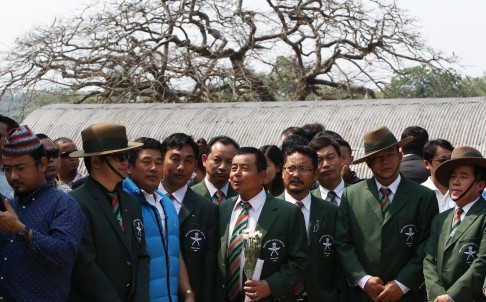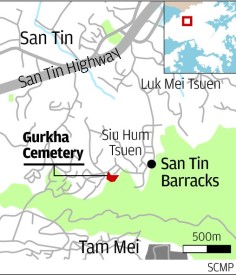Gurkhas say they are denied access to 200 graves at PLA's San Tin barracks
PUBLISHED : Sunday, 13 April, 2014, 5:08am
UPDATED : Sunday, 13 April, 2014, 5:08am
Jennifer Ngo [email protected]

Gurkha veterans and members of the local Nepalese community observe Ancestors' Day earlier this month. Photo: Jonathan Wong
Retired Gurkhas say they are being denied access to at least 200 soldiers' graves located within the People's Liberation Army barracks in San Tin.
The PLA says no such graves exist at either its San Tin or Tam Mei barracks.

Gurkha Cemeteries Trust Hong Kong chairman Narhang Rai says there are at least 200 graves of Nepali soldiers and their family members in the barracks, and that the Gurkha community has been prevented from visiting them.
"We've asked also if we could move the graves out of their controlled area and into our cemetery, but we were refused," said Rai, himself a retired Gurkha.
A PLA spokesman said: "According to our knowledge, there has been no discovery of Gurkha grave sites within San Tin or Tam Mei barracks."
There are 30,000 Nepalis living in Hong Kong, most of them related to Gurkhas who were stationed in the city by the British. After fighting the Gurkhas in Nepal from 1814 to 1816, the British began employing them as soldiers.
Many Gurkhas were stationed in the New Territories, at San Tin barracks, which was known as Cassino Lines before the handover in 1997.
The Gurkha cemetery, just outside the San Tin barracks, opened in 2004 after the trust secured funding to clean up and landscape the area, which had fallen into decay. There are about 700 marked graves in the cemetery, which is difficult to access because the barracks stands in the way. Rai said there were many more graves located beyond the cemetery.
"We actually don't know the exact number of people buried here," he said. "Some of the graves are marked, some not."
Rai added that there were more than 9,000 Gurkhas and Nepali military support personnel in Hong Kong before 1997. Some 500 to 700 Gurkhas remain in the city today.
He said the trust had made informal requests to the PLA seeking access to the graves. The PLA had refused. The trust had also suggested the graves be relocated from the barracks. The PLA did not respond.
Retired Gurkha Khimding Ratna, based at Cassino Lines in the 1980s, is convinced there are graves in the barracks. "From what I know, all Gurkha burials are here [in San Tin]," he said.
Ratna believes the graves are in a wooded area between the barracks buildings and the Gurkha Cemetery. He said the exact location was difficult to pinpoint.
The Nepalese community last weekend observed Purkha Diwas, or Ancestors' Day, which began in Hong Kong a decade ago. It is now a major event for Gurkhas around the world to remember the Nepalese soldiers - known for their skill in combat but often unrecognised in history.
